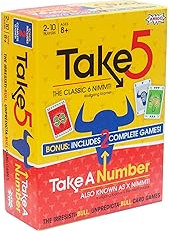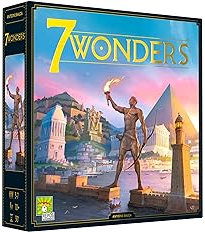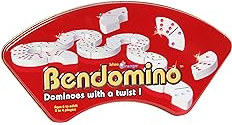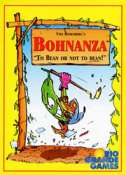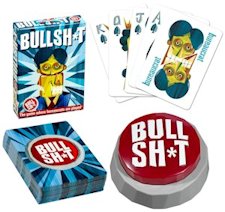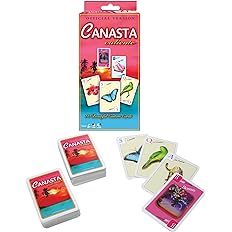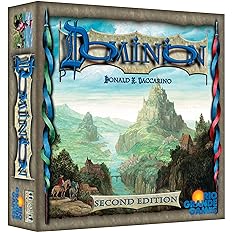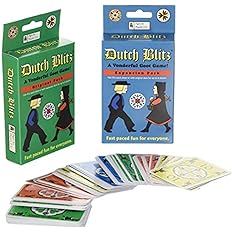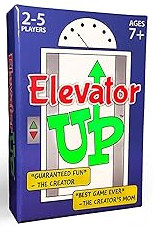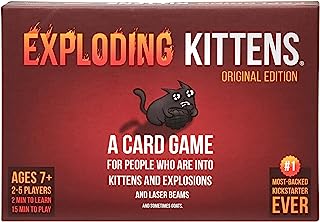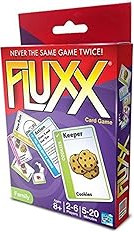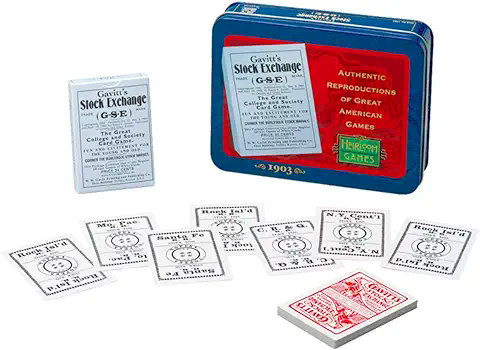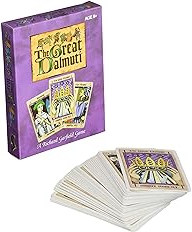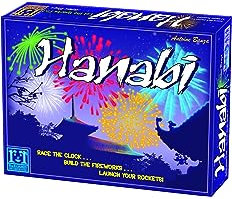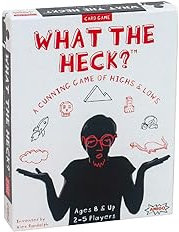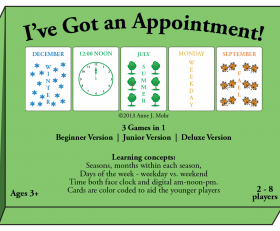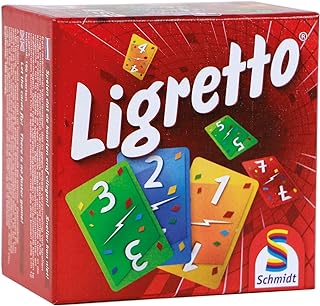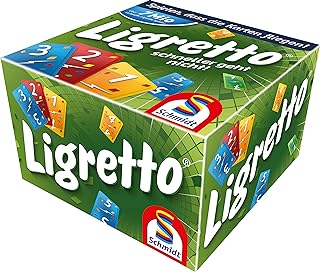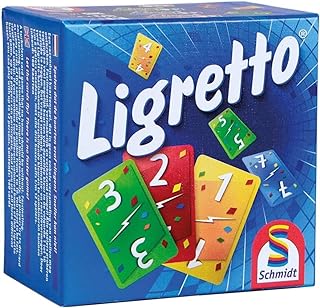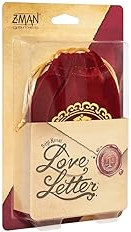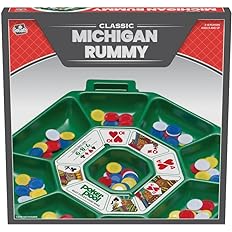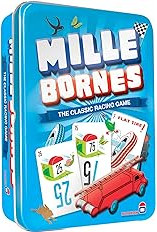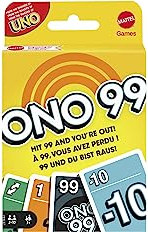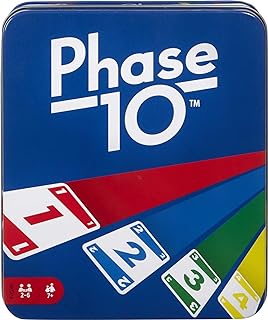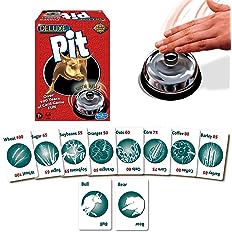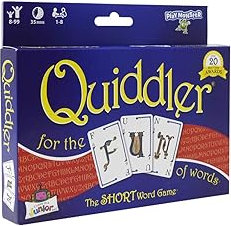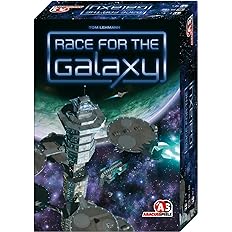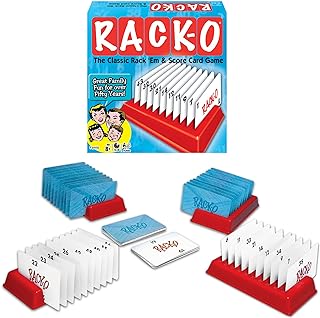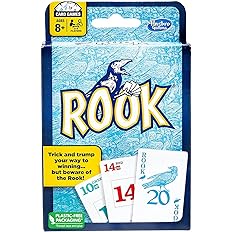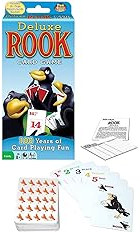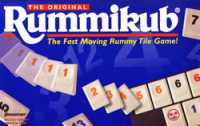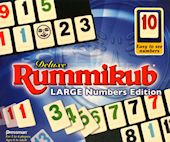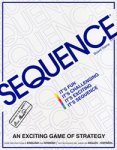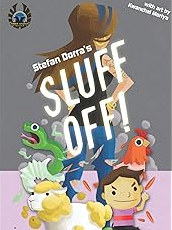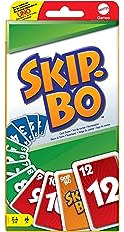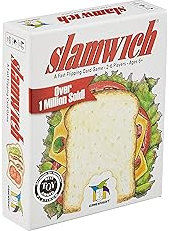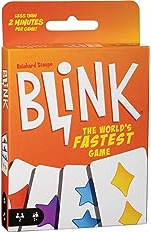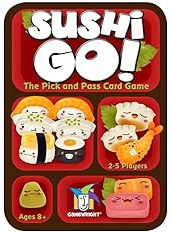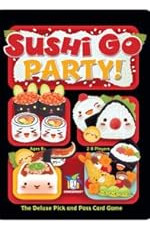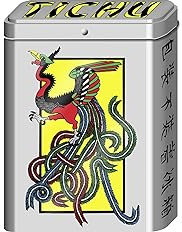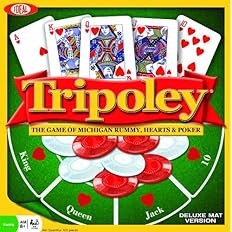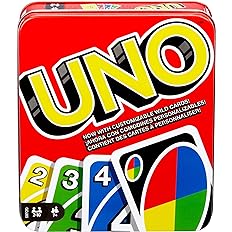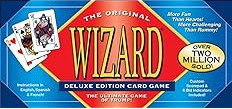Commercial Card games
This page contains links to information about various proprietary card games which require a special pack of cards promoted and sold by a particular manufacturer. I am not actively developing this part of the site, but from time to time I will include here relevant information and links that I come across or reviews of games sent to me by their publishers. Please note that there is a separate page for Collectible Card Games (Trading Card Games). Some of the listed below games are available from amazon.com and can be ordered by following the links next to the descriptions: I earn a small commission on these orders. Since this page has become rather large, here is an alphabetical index to help you find the game you want:
# A B C D E F G H I J K L M N O P Q R S T U V W X Y Z
The ![]() symbol indicates entries that have recently been added to the page. It does not necessarily mean that the game itself is new.
symbol indicates entries that have recently been added to the page. It does not necessarily mean that the game itself is new.
- 1-2-3 OY
- A pack of 90 cards by Dream Green intended for educational games. There are 5 cards for each of the numbers 0 to 16 and 5 wild "OY!" cards. Rules of several games are included, all of which are based on mental arithmetic. The same company makes an A-B-C OY! deck for word games.
- 6 Nimmt! (6 Takes!)
- This is a light-hearted game for 2-10 players by Wolfgang Kramer. It has been reissued in American editions under various names: Category 5, Slide 5, The Walking Dead and Take 5. The pack contains cards numbered from 1 to 104. Each card is worth penalty points (the multiples of 5 and 11 being most expensive), so the aim is to avoid capturing cards. Each player simultaneously selects a card from their hand and these cards are played according to various rules to a layout consisting of four rows. The cards in each row must be in ascending order, and a row cannot contain more than 5 cards. When a player's card would extend a row to six cards, the player has to capture the first five cards of the row; when it won't fit on any row, the player chooses a row to capture. It's difficult to see how to develop an effective strategy, but players seem to enjoy trying. The rule booklet is available from Amigo. The Walking Dead includes a variant in which the aim is to collect points rather than avoid them, and some extra 'Hero cards', one per player, which can be used to play a card out of sequence.
You can order Take 5, an American edition of 6 Nimmt! from amazon.com
- 7 Wonders
- An excellent card drafting game for 3 to 7 by Antoine Bauza, which won the Kennerspiel des Jahres (connoisseur's game of the year) prize in 2011. There are three 'ages' in each of which you begin with a hand of seven cards, play one and pass the remainder to your neighbour. This is repeated until everyone has played six cards and the final card of the age is discarded. The cards represent resources, buildings, military power and other features, and playing a card often requires resources or other cards to be in place. Separately or in combination, cards yield victory points which determine who wins the game when the third age is completed. Each player is also assigned a different 'wonder of the world' and can use cards to build it, gaining benefits in victory points or other powers.
You can order 7 Wonders from amazon.com.
- Abridged
- A commercial version of Minibridge from Out of the Box games. The 52-card pack uses colours (red, green, yellow, blue) instead of suit symbols, and has numbers 2-14 of each colour, with the top four cards of each suit marked with 1-4 dots representing their Milton Work point count. Since cards of the same rank differ only in colour, these cards will be unsuitable for some colour-blind players, but it is easy to substitute a standard deck of playing-cards.
- Alpha
- There are 74 cards representing letters of the alphabet - 42 consonants, 32 vowels and 2 wild cards. While the consonant cards each represent a single letter, the vowel cards give a choice of two vowels and the wild cards represent any letter. Several games for these cards are offered; for example in New Word, players take turns to make the highest scoring word they can from the cards in their hand together with those left on the table from the previous play, unused table cards being discarded after each turn.
- ALPHAbet playing cards (archive copy)
- This was a 110 card pack consisting of letters A to Z in four suits (red triangle, green circle, blue star and brown square) plus four jokers and two further wild cards. Rules were included for five games involving making words, either on a layout or by collecting cards in your hand.
- Armory
- A combat game for 2-4 players, but not a CCG (trading game). Each player has a deck of 60 cards containing two warriors and an archer who are to be provided with appropriate armaments (22 cards per deck) and then protected by a guardian (5 cards). Each deck includes 30 "mystic" cards can be played to attack other players, to counter attacks and for various other purposes. The two final attack cards can be used to win the game when your three combatants are fully armed and guarded.
- Authors
- This American version of Quartet, Go Fish or Happy Families is sometimes played with standard playing-cards, but originally cards showing famous authors were used. Nowadays various other educational series - presidents, baseball players, inventors, etc. are also available. Players try to collect sets of four cards by asking other players for them.
You can order Authors cards of various types from amazon.com - Barons of Fyn
- This is a kind of board wargame, but played entirely with cards, some of which represent land. The game components are free - you can download and print out the rules the card designs from the web site, cut out the cards and play.
- Baseball
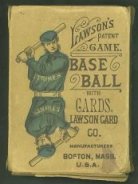 Baseball card games are an American tradition dating back to the late 19th century (Lawson's Patent Base Ball Game was patented in 1884).
Baseball card games are an American tradition dating back to the late 19th century (Lawson's Patent Base Ball Game was patented in 1884).- More modern simulations include Sportscards Baseball, which includes a pitching deck and a batting deck which includes some cards allowing "coaching moves". The cards come in a handsome wooden box which unfolds to represent the playing field, with metal pegs for the players. An outline of the rules is given on the cards, but these are quite hard to understand unless you are familiar with the workings of the real game of Baseball. The game can be ordered by e-mail from John Carr at .
- The American novelist Paul Auster has also designed a baseball-based card game called Action Baseball that was published in his recent Hand to Mouth: A Chronicle of Early Failure (NY, Henry Holt, 1996). The game needs 2 packs of 96 cards each, a game board, several tokens, a scoring board. The cards are printed inside the book, and the rules are given as an appendix.
- Battlefields of Olympus
- This two-player game from Smartass Games is played with 100 cards - 50 warrior cards used for battle, 30 action cards that modify the play in various ways, 14 land trophy cards for which the players compete, and 10 Ares (God of War) cards that precipitate battles. The fighting between warriors uses an unusual mechanism in which the cards are placed top edge to top edge, and the result depends on whether the colours on the top right of one card match the colour on the top left of the other.
- Beat the Bookie
- An simple but effective game based on horse race betting - requiring judgement of probabilities and with plenty of scope for psychology and bluff. There is a pack of 44 cards, each showing a balanced set of odds on a four horse race, plus two sets of cards representing the four horses (red, green, blue, black). An odds card is turned up and one player (the bookie) decides secretly which of the four horses will win the race. Then the other players bet on the horse(s) of the choice, the winner is revealed and the bets are settled. The inventor is Andrew McKinnon (acmckinnon@netscapeonline.co.uk)
- Bendomino
-
A double-six set of 28 dominoes each of which has a 120 degree bend, so that loops can be formed in the layout. (In theory there are two possible versions of each non-double tile, since the bend could be to the left or right. The set contains just one version of each - if the tile is placed with the low end towards you, it bends to the right if the spot total is odd and to the left if it is even.)
You can order Bendomino from amazon.com. - Blind 31
- This game by Gary Woitzik combines the objective of 31 (Scat, Blitz) with a play mechanism similar to Golf. It uses a special 65-card pack which consists of the 52 cards of a standard Anglo-American deck plus 13 cards with special functions reminiscent of those found in UNO and other games: 2 Wild, 2 Reverse, 2 Skip, 5 Take All, 1 Scramble and 1 Swap.
- Blindes Huhn (Blind Chicken)
- An unusual trick taking game, invented by Michael Schacht. Having sorted your cards at the start of the game, you are only allowed to play cards from the ends of your hand - either the extreme right-hand card or the extreme left-hand card. In the original game published by Berliner Spielkarten in 1997, the pack consisted of 60 cards numbered from 0 to 59, some of which were penalty cards showing rotten eggs. A more elaborate version Blindes Huhn extrem was published by Abacus Spiele in 2017. This has 50 cards numbered from 0-49 some of which depict bonus pigs or penalty chickens, and some additional cards representing penalties for players who take a trick with more than one chicken and bonus cards for winners of tricks including exactly one pig. Normally the highest card wins the trick, but in the very last trick the 0 (sow) is highest, and the winner of the last trick gains some extra privileges.
- Blink - see Speed
- Bohnanza
- This is the classic bean growing and trading game. The pack consists of 104 cards representing eight varieties of bean, the most valuable types being scarcest. In front of you you lay out the beans you are growing - at most two varieties at a time, or three varieties if you invest in an additional plot of land. At your turn you acquire more beans that you must either plant or trade with other players. You earn money by harvesting beans, but it's most profitable to harvest a large number of the same variety; sometimes you are forced to harvest prematurely to create space for new varieties that you are forced to plant. The rule booklet is available from Amigo.
- You can order Bohnanza from amazon.com
- Boon
- This is a specially designed deck for playing a version of Sheepshead. It consists of 32 cards for playing the game: 6 cards numbered 1 to 6 in each non-trump suit (blue, green, red) and 14 golden trump cards numbered 1 to 14. Each card has its point value printed in the centre, corresponding to the card values when played with a standard deck. In addition there are 20 'victory cards' used for scoring.
- Boosted
- A version of Higher or Lower played with a special 60-card pack (1 to 15 in each of four cards) plus 30 'booster' cards with various powers such as making other players pick up cards, changing the required direction required from 'higher' to 'lower' or vice versa, allowing several cards to be played at once, stealing or destroying another player's booster, and so on.
- Brainbo
- A game of colour matching and reaction speed in which the aim is to be the first to get rid of your cards. Cards have the name of a colour printed in white on a background which may be a different colour. There are eight colours and 64 cards covering all possibile combinations of word and background colour, plus 8 'carte blanche' cards, 8 'brainbo' cards. The 77th card is used to indicate the matching rule in force: if the 'WORD' side is showing, the background colour of each card played must match the word on the previous card, while the 'COLOUR' side indicates that the word on each card played must match the colour of the previous card. A 'carte blanche' card can be played at any time, and allows any card to be played by any other player. Playing a 'brainbo' card requires everyone else to draw a card and the indicator card to be turned over, changing the matching rule.
- Bridgette
- A two-player game based on Bridge, first published by J.Q.Kansil in 1970. The 55-card Bridgette pack consists of a standard 52-card pack plus three extra cards known as Colons: the Grand Colon matches aces; the Royal Colon matches Face cards (K,Q,J) and the Little Colon matches the numeral cards 2-10. A Colon can be discarded on a matching lead: it loses the trick but stops the opponent from leading a card of the same suit to the next trick. The 2004 edition from Xanadu Leisure introduced a new variation: Bridgette Showdown, and the set includes two 55 card packs plus the dice, dice cups, wooden suit markers and bidding boards used for secret simultaneous bidding in Bridgette Showdown.
- BS Button Game
- This package from DollTV is used to play the traditional game of Bullshit (or Cheat). It includes a red button which speaks the word "bullshit" in a celebrity impression voice - this is pressed when making a challenge. The deck contains the standard 52 cards plus two wild jokers and two 'bureaucrat' cards, which may be played to cancel a challenge and specify the rank of cards to be played next. The BS Button Game can be ordered from amazon.com.
- Bux
- This is a quick card game in which by an original process of auctioning and trading players collect sets of three matching cards which they can then sell for chips. The set contains a pack of cards, chips of various denominations, and a plastic tray to hold the bank and the draw and discard piles. The 48 cards used for play have one of the four suits and one of four shapes on the front, and a chip worth 25, 50 or 100 is shown on the back. Three special "BUX 1-2-3" cards are shuffled into the deck to determine when the game ends, and four special cards with rules.
- Canasta Caliente
- This is an attractive special deck for playing canasta. The ranks from ace down to 4 are each marked with their point values and show fruit on the numeral cards and crowns on the courts. The red and black threes are replaced by "bonus" cards with fireworks and "stop" cards with a stop sign, and the twos and jokers become "small wild" and "big wild" cards showing mice and a parrot. In addition to the normal double deck of 108 cards there are two "caliente" cards. If used in the game, these allow a player to draw extra cards at a cost of 100 points deducted from the team's score.
You can order Canasta Caliente from amazon.com. - Card Golf
- This golf simulation uses a 51-card pack whose cards represent golf clubs each of which sends the ball a specific distance - there are 9 woods, 24 irons, 8 wedges and 10 putters. From a 14-card hand the player selects a set of clubs whose total yardage matches that of the hole being played, or exceeds it by as little as possible. The number of strokes for the hole is the number of cards used plus a penalty for any excess distance.
- Cash Trader
- In this game from Girrawaa Games in Australia, players race to accumulate one million dollars of wealth in their trading companies. The mechanism is similar to that of Mille Bornes, but with a greater variety of special cards. The deck of 216 cards includes license cards to that permit a player to start trading, cash cards that represent profit, and a variety of cards that can be used to hinder opponents in various ways or to protect one's own profits from attack.
- Conundrum
- This game by Josh Young nicely combines several play mechanisms. It is a shedding game, in which players try to get rid of their cards, either by matching the previous card following a pattern such as higher, lower, same suit or opposite colour, or by collecting and laying down combinations - pairs, straights, etc., but it also has the form of a compendium game with eight possible shedding rules. Having seen their cards, players can choose whichever of the available rules would best suit their hand, but cannot use the same rule again in the course of the game, which therefore lasts for eight deals. The set includes two standard 52-card packs for playing, and eight sets of eight rule cards in different colours to accommodate up to eight players.
- Corporate Shuffle
- Another climbing game from Wizards of the Coast, in which the cards depict characters from the Dilbert cartoon series, It is similar to The Great Dalmuti but with some extra cards that have special effects.
- Cosmic Connexion
- This word game is played with a deck of 24 cards corresponding to the letters of the Greek alphabet. The alphabet cards are played to form a diamond-shaped grid on which the players trace English words, using the cards to represent English letter strings corresponding to the name or pronunciation of the Greek letter. There is a second deck of 28 'celestial' cards showing zodiac signs, planets and other celestial bodies, each with a point value: these cards are given out as rewards for making words.
- Coup d'Etat
- A four-player game related to Barbu, produced by Parker Brothers in the 1960's. It uses a 32 card pack and some extra charts and equipment. The innovation in this game is the "coup", by which another player can try to take over the declarer's role for the rest of the current set of hands.
- Cows Can't Dance
- (... but they like to be asked). This game from Gamewright contains 52 cards plus two spares, which can be used as wild. There are 4 lady and 4 gentleman dancers in each of four suits, 6 Madame Fifi cards, 7 bulls and 7 cows. This is a draw and discard game in which players try to score points by making pairs of dancers, which are placed on the table. The discarded cards are laid out separately in the "dance hall" in the centre of the table. Normally a pair is formed by a card from your hand and one from the dance hall. A lady and gentleman of the same suit can dance together; Madame Fifi can dance with any lady or gent and can break up a dancing couple to get a partner; cows and bulls can only dance with each other, and can ask for a partner from another player's hand.
- CrossCrib®
- This is a commercial version of Table Top Cribbage: you get a board on which to lay out the cards, scorepads, and rules with variations, including versions for more than two players. The aim is to play cards on the 5x5 board so as to make high scoring Cribbage hands: one player scores for the rows, the other for the columns. Here is an archive copy of the review of it in The Game Report.
- D! Bone
- A set of 29 robust plastic cards equivalent to a double-six domino set with no double blank but with two double wild cards. These are used for a draw and discard game - the play mechanism is similar to Rummy or Tonk, but the "spreads" are chains of cards whose touching ends match and open ends add up to a multiple of five, as in a fives-style domino game. These can be "hit" by extending them to longer scoring chains. Several other games with the same cards are also offered, some of them more similar to classic dominoes.
- Dominion
-
This enormously successful game by Donald X Vaccarino is based on the drafting mechanism which evolved as a way of building decks in trading card games such as Magic The Gathering. In Dominion each player begins with the same small deck of cards, from which a hand is drawn. Playing cards from hand enables the player to acquire other cards of their choice, which are placed in the player's discard pile along with the played cards. After each turn, players replenish their hands and when their draw piles are exhausted, they shuffle their discard piles to form new draw piles enriched by the extra cards they have acquired. The basic set includes 500 cards with various powers and properties, and numerous expansions have been published, which increase the range of cards available.
You can order Dominion from amazon.com. - Dual Value Playing Cards
- This is a 52-card pack with two jokers from Clever Playing Cards, in which each card has a primary and a different secondary value - for example the 5 of clubs also has a secondary value of jack of hearts. The web site has rules for a number of games designed to be played with this deck.
- Dutch Blitz
- This is a version of the traditional competitive patience game known as Racing Demon, Pounce or Nerts, but played with special decks containing numeral cards 1 to 10 only (40 cards in each deck). It is sold as a game of the Pennsylvania Dutch.
You can order Dutch Blitz from amazon.com - Eleminis
- A game from Smileypop in which players race to establish a row of five different element cards (Rock, Air, Fire, Water and Plant) in front of them. At your turn you draw a card and play it face up on your own or another player's row, in an empty space or replacing the card that was there. Each element can replace two of the other elements and has two elements that can replace it. In addition to 12 of each element the 108-card pack contains 12 wild star cards, 6 worthless trash cards (for clogging other players' rows), and 5 each of 6 types of action cards which cause the player who draws them to discard one or two cards from any row(s), swap two cards, move a card, reverse the direction of play or miss a turn. When someone completes their row, everyone scores according to the quality of their own row.
- ElevatorUp
-
A version of Shithead using a specially designed 50-card pack with four cards for each of the nine floors 2-10 and 14 special cards (4'lobbies', 4 'new buildings', 4 'stuck' cards one 'penthouse' and one 'door closed'). Rules and a video tutorial are provided on the game's website.
You can order ElevatorUp from amazon.com. - Entrump6
- A two-player game by Niyi Kolade using a 53-card pack: 30 asset cards with positive values, 20 liability cards with negative values, and three 'Entrump6' cards with value +6. On each of the asset and liability cards is a business-related word, and the card value corresponds to the number of letters in the word. The aim is to capture cards from the 'stage' by playing positive cards from hand. For each player's first capture the played card and the cards captured from the stage must total 6, or the player may simply play a 6 from hand. Subsequently players may also capture cards or sets of cards from the stage which total plus or minus the value of the played card. The game ends when a player has made six 6-captures, and each player then scores the number of cards captured less the number of negative cards remaining in hand. The game is available from the inventor Niyi Kolade: call +234 8067557709 or e~mail .
- Exploding Kittens
-
A game for 2-5 players played with a special 56-card pack. Each player must normally end their turn by drawing a card from the deck, and if this card is an exploding kitten they are eliminated unless they are able to defuse it using a 'defuse' card. Before drawing they may play other cards from their hand which have special powers such as stealing a card from another player, skipping their turn so that they do not have to draw, forcing the next player to take two turns, looking secretly at the top few cards of the deck, shuffling the deck or negating another player's action.
You can order Exploding Kittens from amazon.com. - FaceEater
- A zombie-themed card game loosely based on Contract Rummy, but with numerous extra cards that have special effects. The contract for each deal is not determined in advance but chosen by the winner of the previous hand before the next deal. 104 of the 192 cards correspond to two standard 52-card decks, and the remaining 88 cards have various powers, such as giving bonus or penalty points, triggering card exchanges or counteracting the effects of other cards. The design of the cards could be clearer: they are single headed, and the 104 ordinary cards have an index (A,2,3,...,J,Q,K) in only one corner, so players will need to turn all their cards upright to see what they are. "Suits" are differentiated only by the narrow coloured border of the card, and most of the card area is filled with a zombie picture which gives no obvious clue to its rank. The rules supplied with the game are supplemented by a FAQ on the game's web site that clarifies some ambiguities.
- Family Business
- Each player (there can be up to six) controls a gang of nine mobster cards. During the game, mobsters may be placed on a hit list (lined up against a wall), and the mobster at the top of the hit list is liable to be executed when a mob war takes place. Play is from an action deck of 56 cards - on each turn a player draws a card an plays one. The effects of cards are to place mobsters on the hit list, change the hit list sequence, rescue mobsters from the list, start a mob war, counter the actions of other players, and so on. As you would expect, the winner is the last player to have any mobsters left alive.
- Famous Games
- The World 's Smallest Sports Games from Rob Bartel's Famous Games Co. There are six games in the series: Famous Fastballs (baseball), Famous Forehand (tennis), Famous 500 (motor racing), Famous First Downs (American football), Famous Fairways (golf) and Famous Flagships (sailing). Each game is a neat two-player simulation of the relevant sport using just nine cards. Each set also includes two extra cards summarising the rules and a folded sheet which introduces the game and sometimes serves as a small game board. Some also require coins as playing pieces and a pen and paper to keep score. Each game has a different and somewhat original game mechanic. The web site provides online tutorials which sometimes contain rule details not provided with the cards. Also, as with many sport simulations, you generally need to have a basic knowledge of the sport itself to understand how to play the simulation.
- Fiasco
- A trick-taking game in which each player tries to collect cards of a particular suit. There are 54 cards in the decks, ranking 1-2-3-4-5-6-7-8-K, and there are six suits, but the six kings and six fives do not belong to any suit. Kings are bonus cards, but if you win a five you have to give away a scoring card. The Fiasco web site includes an entirely fictional "history" of the game.
- Five Crowns
- A rummy game similar to Three-Thirteen, played with a 116 card deck. There are no aces or twos but there is an additional suit of stars and six jokers.
You can order the Five Crowns Card Game from amazon.com
- Flaps
- An enhanced version of Switch or Black Jack (the British form of Crazy Eights) by Paul Feagan. There are many additional special cards, and the rules for each are written on the cards. The game is named after the fours which are "Flaps" cards: when anyone plays a four other players can play fours without waiting for turns, but with no player playing more than one four in succession.
- Flinch®
- Flinch was copyrighted in 1901 by A. J. Patterson, then in 1903, by Flinch Card Co. and later revised in 1913. In 1904 Parker Brothers bought the exclusive licence to sell it, and finally took over Flinch Card Co. in 1938. It is a competitive patience game a little like Spite and Malice, played with a 150 card deck consisting of ten each of cards numbered from 1 to 15. Rules are available on this archive page. The game is now produced by Winning Moves.
- Fling (formerly called Suds)
- A fast game for young children from Gamewright. The pack of 54 soap-sud shaped laundry cards contains peaked hats, T-shirts, boxer shorts, pants, socks and sneakers. There are also three wild cards which count as anything. The players each have a three-card hand and a face-down stock used to replace hand cards as they are used. There are no turns - players get rid of their cards as fast as they can, building face-up piles of six cards in the correct sequence on the table. The first player who runs out of cards wins.
- Flocks
- A children's game in which players try to collect sets of three identical birds (flocks) by a draw and discard mechanism to which is added the option of asking another player for a card rather than drawing from the stock or a discard pile. The 72-card pack has 3 each of 24 different cards. There are 21 different birds and 3 kinds of special card: wild Golden Eggs, Spectacle Birds that can look at another player's cards and Crazy Cuckoos which enable the player to swap flocks with an opponent.
- Fluxx
- A boldly original card game, in which the rules are written on the cards. Fluxx was published in 1997 by Looney Laboratories. Basically it works on a draw and discard principle - you draw cards from the stock and either play them in front of you or in the centre of the table, and in some cases discard cards from your hand or from the table. The unusual feature is that the cards you play alter the rules of play and the winning conditions. Because the objective can change unpredictably the game is rather wild and there is a considerable luck element. Kristin Looney writes: "So yes, Fluxx is largely a luck oriented game, which means that hard-core strategy game fans might not care for it. Rather, it's just a good, fun, kind of silly family card game, which kids of all ages will enjoy."
See also Steffan O'Sullivan's Fluxx Fix page, which has a review of the game and some suggested changes to the rules.There is now a range of themed variants of Fluxx which can be ordered from amazon.com
- Forrrre! [archive copy]
- A draw and discard game with a golf theme. The 51-card pack includes 28 scoring cards ranging from "hole in one" (-4) to bogey (+1) and 23 special cards. A hole ends when a player manages to play four scoring cards. Meanwhile the 23 special cards can be used to block other players, to steal cards, to remove blocks and so on.
- Frank's Zoo
- This is the English language edition of Zoff im Zoo, published by Doris Matthäus and Frank Nestel in 1999. It is a climbing game, best for 4-5 players, played with a 60 card pack consisting of five each of whales, elephants, polar bears, seals, crocodiles, lions, perch, foxes, hedgehogs, goldfish and mice, four mosquitos and one chameleon. The basic play is similar to President, but with several added complications. The rules on which animals beat which are subtle - for example, elephants beat crocodiles and crocodiles beat perch but elephants don't beat perch. You can play an equal sized set of animals that beats the previous play, or a set of the same animal as the previous play but with one more card. The chameleon is a wild card that takes on the identity of the animal it is played with. A mosquito, normally the weakest animal, can masquerade as an elephant when played with an elephant. Players score according to the order in which they run out of cards, and there are special scores associated with lions and hedgehogs. From the second deal onwards, players form partnerships according to their scores.
- Free Parking
- In this game from Winning Moves each player has a parking meter. They can run errands worth various numbers of points, but they must make time for these errands by feeding their meter. In addition to cards representing the meters with sliders showing the remaining time, the deck contains errand cards, cards for feeding your meter, free parking cards which enable an errand to be run without using meter time, and special cards that send another player's meter to zero, cause a player with no time on their meter to be fined ("Officer Jones"), or enable you protect yourself against a fine. Each player has a hand of six cards, and a turn consists of replenishing your hand to six and then playing a card. You can also draw a card from a second deck, known as "second chance" cards, and follow the instructions on the card.
- Frog Juice
- This Gamewright game is a sort of hybrid of a fishing game and a quartet game, with some extra features. It is based around the theme of collecting the ingredients for spells. The pack consists of 44 ingredients cards, 4 witches, 2 princes, 2 maidens, a black cat, a "witch wash" and five different spells.
- F*ck This!
- A rude word game from BTRC. There are 125 cards, 120 containing words or groups of words and 5 giving bonus points. The cards are played to form a crossword-like grid. Players score points for completing obscene, blasphemous or otherwise offensive phrases. Available as a download of the rules and card images or in printed form ready to play.
- Fuddy Duddy
- This is an original draw and discard game with 4-card hands and four discard piles, in which the object is to collect a set of 1-2-3-4 of a single colour. There are 5 colours - red, yellow, green, blue and white (dud) and the 52-card pack contains three of each 1, 2 and 3 but only one 4 of each colour. There are two wild 4's, which can be used as any colour except dud, so a dud set (a fuddy duddy) is the most difficult and valuable to collect; also the most risky since there is a penalty for any odd dud cards left in players' hands at the end.
- Gang of Four
- This is one of the most successful commercial adaptations of a climbing game. It was adapted from the Chinese game Choh Dai Di (Big Two) by Lee Yih and first published in Hong Kong in 1990. The cards are attractively designed in an unusual style reminiscent of Chinese communist poster art. The pack consists of cards numbered from 1 to 10 - two red, two yellow and two green of each number - plus 4 extra cards. Each numerical rank represents an occupation, from Student up to General, and the extra cards are the Chairman (highest), two Vice Presidents (next highest) and a Student Leader (ranking slightly above an ordinary student). As in all such games the aim is to get rid of your cards. The cards can be played singly, in pairs, in triples, in fours of a kind (gangs of four) and in five-card poker combinations. A combination is beaten by a combination of the same type with better cards, or by a gang of four or more equal cards, which beats anything. The scoring system penalises anyone left with a large number of cards, and this creates an interesting tension between three possible objectives:
- to maximise your chance of eventually winning the hand, for which you must not let go of your strong cards too soon;
- to reduce your hand to a safe level, so that you will not lose too much if someone else wins, for which you must get rid of cards as soon as you can even if these leaves you with cards that will be hard to dispose of;
- to go out as quickly as possible, to try to catch at least one other player with a high score, which may taking an early risk that some play you make will not be beaten.
- Gavitt's Stock Exchange
- This lively 1903 stock trading game, probably the inspiration for Parker Brothers' Pit, was reissued by Out of the Box Publishing in 2003. The deck consists of 49 cards: eight shares in each of six railroad companies, plus one telegram card. Players simultaneously trade cards or pairs of identical cards, sight unseen, aiming to collect all eight shares of a company, at which point they can shout "Topeka" to win.
-
You can order Gavitt's Stock Exchange from amazon.com
- Gawp
- This game involves recognising sets of cards from a layout: each card shows concentric rectangles in three colours, and the aim is to spot sets of three cards with the correct colour relationships. This game might appeal to people who like SET - the game play is somewhat similar but different types of pattern are involved.
- Gem Rummy
- This is an enhanced version of Gin Rummy played with a special 52-card deck, which is like a standard international deck except that the cards show gems as well as a rank and suit. There are 8 different types of gem, each of which appears on seven cards (Kings have two different gems, other cards have just one). As well as sets and runs players can from 'stashes' of four matching gems and score a bonus for having 8 different gems in their 11-card hand ('gem parts'). The assignment of gems to ranks and suits is irregular to avoid particular types of set and run always being associated with gem parts bonuses. There are also two dice used to decide the maximum deadwood with which a player can knock and the cards required for a special two-card compbination called 'Queen's diamond'.
- Geoplunge
- This US geographical game was invented by Alan Fishel and published in 2004. The set consists of 98 giant cards (127mm x 76mm) and a rule book. The core of the game is a 50-card deck corresponding to the states of the USA, each showing a map of the state, its rank (1st to 50th) in size, population and "statehood" (date at which it became a state of the USA), its capital, three largest cities, bordering states, state flower and state bird. The rule book describes several games that can be played with these cards, and others are described on the game's web site. These include trick-taking games, rummy-like games, and quiz games where players try to identify opponents' cards from clues. In addition to the state cards, the set includes a deck of 36 GeoChallenge cards that are used to select the clues given in quiz games - they have instructions like "opponent chooses either the Flower or Bird to read" - and a deck of 12 GeoPower cards (4 size, 4 population, and 4 statehood) that are used to determine the card ranking in some of the trick-taking games.
- Gettalife
- A draw and discard game designed by Steve Endres. Players score points by building a 4×4 grid of cards: each column holds one of the four suits (relationship, wealth, knowledge and experience), and a complete column contains a blue, orange, silver and gold card of the suit. Grids are built upwards and sideways, starting with the blue cards at the bottom. The more valuable cards towards the top of each column are in shorter supply. There are bonuses for completing a row or column. The pack also contains "hard knocks" cards that can be used to block an opponent's grid, "silver spoons" cards to defend against such blocks, "damage" cards to erase an opponent's score for a card, and cards with various other special effects.
- Gift Trap Card Game
- Each card represents a gift. Players give each other gifts, choosing from the cards they are dealt. The recipient, without knowing who gave what, decides which gifts he or she prefers. The giver of the most welcome gifts wins the "trick" and the first player who wins seven tricks wins the game. The cards can be printed from the web site and cut out, or the cards from the Gift Trap board game can be used.
- Glory to Rome
- Designed by Carl Chudyk and published by Cambridge Games Factory in 2005, this game for 2-5 players has a mechnism similar to San Juan, but is considerably more complex. Victory points can be scored for buildings and for materials stored in one's vault. Each card in the 144-card "orders deck" can represent a role, a building or a material. To execute a role one must play a card of the appropriate type from hand or have a card of that role installed as a "client". Roles include hiring a client, gathering and storing material, starting a building, adding to a building, and moving material from store to vault. It is also possible to requisisition materials from other players. Buildings require various quantities and types of material and provide extra powers as well as victory points when complete. The game also includes also some smaller decks: 6 jacks, which are wild role cards, and 36 sites on which buildings can be erected. The considerable effort required to understand this game is worthwhile for those who enjoy a game with moderately deep strategy.
- Go Bark
- A version of Go Fish played with a pack of 54 cards: 4 cards of each of 12 breeds of dog and six special "Go Bark!" cards which can be used to redirect a demand for a card to another player.
- Go Knights Go Dragons
- This is an expanded version of Go Fish from Dr. Dan Sullivan of Earwig Enterprises. There are 13 knights of different colours, each built from four cards, and 13 four-card dragons in the same colours as the knights, plus one 2-card knight (squire) and one 2-card pseudo-dragon. Players collect cards from these 28 sets by a version the usual Go Fish mechanism. In addition there are 13 "breath weapon" cards, which when melded along with a knight or dragon of the corresponding colour can be used to attack and destroy the dragon or knight of the same colour. By my count that makes 121 cards in the deck - presumably the 126 mentioned on the web site include some spares.
- Goat Lords
- A draw and discard game in which players score by collecting pairs of goats. Players can also 'duel' for goat pairs by playing matching goats from their hands. The deck contains 110 goat cards, plus 38 action cards that are used only in the 'strategic version' of the game. Rules are available here.
- Go Surf
- This 45-card pack illustrates 11 types of surfing manoeuvre (4 different coloured cards for each) and there is one wipe-out card. The web site suggests several games to play with these cards - mostly adaptations of children's games such as Go Fish, Old Maid, Memory, Crazy Eights, Slap Jack and Pig (Spoons).
- Gone Bush
- An Australian shedding game, slightly reminiscent of Crazy Eights, played with a special 45-card deck depicting wildlife, hunters and bushfires.
- The Great Dalmuti
-
This is a game of the climbing group, somewhat similar to President. The main innovation is that there are more cards of the low ranks than the high, so the losing players can sometimes play a such a large set of low cards that they can't be beaten by the players with high cards. The deck contains 80 cards; there is one card of the highest rank (Great Dalmuti), two of the second, three of the third, etc. down to twelve of the lowest (Peasants). In addition there are two Jesters, which are wild. Sequences are not allowed, but Dave Howell of Wizards of the Coast, Inc. writes:
The Great Dalmuti was developed from a variant of scum/asshole/etc. that did have sequences as an allowable play. It was taught to Richard Garfield by the name "The Great Dalmuti". We deliberately removed the sequences option as needlessly complicating the game. We also experimented with a couple of versions that had trump suits.
You can order The Great Dalmuti from amazon.com
- The Great Running Game
- This is a fairly detailed simulation of a Rugby Union game. There is a pack of over 100 cards representing various runs, tackles, kicks, catches, pick-ups and sequence plays. These are used by the two players to move the ball back and forth on the pitch, which is divided into 5 metre bands. There is also a pack of 12 cards representing the referee's decisions, which are invoked when certain cards are played, and 12 cards for determining the results of line outs, scrums, drop goal and conversion attempts.
- Green Thumb Cards
- A game with a gardening theme. Some of the cards represent plants of various types and the aim is to score points by playing matching sets of these in the area in front of you (your garden). Other cards are used for attacking other players' gardens or defending your own, or cause events such as natural disasters. At the start of each turn you replenish your hand to six cards and then play one of these.
- Gubs
- A family card game for up to 6 players by Cole Medeiros. The game uses a draw-play-discard mechanism, the aim being to have the most "gubs" face up in front of you at the end of the game. As well as "gub" cards, the deck includes various events, barricades, hazards, traps, tools and interrupts, which enable players to steal each other's gubs, protect their own gubs, dismantle other players' protection, and cause various other events. There are are also three letter cards, the drawing of the last of which ends the play.
- Guillotine
- An original card game from Wizards of the Coast in which French nobles are lined up for execution, your aim being to arrange them so as to achieve the most prestigious collection of heads. It has no connection with Scott Marley's card game Guillotine (published in 1983).
- Hanabi
-
This very unusual game by Antoine Bauza deservedly won the coveted Spiel des Jahres prize in 2013. The players do not compete but try to co-operate with each other to build a firework display consisting of cards in ascending order from 1 to 5 in each of five suits. What makes this hard is that you must hold your cards facing away from you, so that you see the cards of the other players but not your own. At your turn you can give a 'hint' to another player about what cards they hold, or you can discard a card out of the game, or you can try to play a card to the display. If you play a card that does not fit, the Gods send a lightning bolt, and the third time this happens the game is lost for a score of zero. If you get to the end of the pack without disaster, the whole group scores according to the number of cards in the display, the maximum being 25. The 60-card pack includes a sixth, multicoloured suit for an advanced version of the game.
You can order Hanabi from amazon.com. - HeartSwitch
- A Hearts variant from Hearts expert Joe Andrews. Eight cards are added to a standard 52-card pack: one Witch in each suit and four Magicians. The Witches rank between Jacks and Tens. Those in hearts and spades increase your penalty points while those in clubs and diamonds reduce them. The suitless Magicians are played like the Excuse in Tarot. They can be played to any trick to avoid following suit and always lose the trick.
- Heavy Gear Fighter - Showdown in the Badlands
- This is a game for two players, which simulates a combat. Each player has a hand of cards representing powers and resources. This game seems akin to a Collectible Card Game in the way it is played, though it uses a fixed pack of cards from which the players' hands are dealt. Here is an archive copy of the rules.
- Hero House
- The pack has 56 cards: 14 each of heads, bodies, legs and primes. The prime cards are complete heroes; three-card heroes can be constructed from one card from each of the head, body and legs suits. Within each suit the cards have from 1 to 4 black or white dots, which determine their fighting strength against monsters, which are heroes formed by the players' discards. The aim is to collect a set of heroes that is 'balanced', with an equal number of black and white dots.
- High Society
- An auction game for 3-5 players, by Reiner Knizia. Each player has a supply of money cards which are used to bid for cards representing luxury possessions; these possessions are worth from 1 to 10 points in the final scoring. Among the cards to be bid for there are also recognition cards, which double the value of possessions, and misfortune cards, which reduce your score for possessions. When a misfortune card appears, players bid to avoid it: the first player who drops out of the bidding gets it, while the others pay what they bid. The player with least money at the end is eliminated and cannot win; the winner is the player with the greatest number of possession points among those who remain.
- Hol's der Geier
- A game of bluff by Alex Randolph, closely related to Gops and also known in English editions by various names including Raj, Beat the Buzzard and What the Heck. Each player has a deck of bid cards numbered from 1 to 15, which are used to bid for prize cards: there are mice with positive values and vultures with negative values. A mouse is won by the highest unique bid and a vulture by the lowest. Equal bids cancel.
You can order What the Heck from amazon.com - Horse Show
- The pack for this Gamewright game consists of 32 different cards representing named horses, each with different abilities, 12 "assist" cards, which can be used to boost any horse's chances in a particular type of event, and 15 "blue ribbon event" cards in the categories Hunter, Jumper, Dressage and Equitation (there is one "dealer's choice" event, which can represent any of these types). Each horse show consists of three events, represented by blue ribbon cards drawn from the shuffled event card stack. Each event card also specifies advantages and penalties for particular horses that might enter. The horse and assist cards are dealt to the players, who decide how to deploy them, the aim being to collect as many blue ribbons as possible for winning events at the four horse shows which make up a game.
- House of Lords
- This is a game for up to four players, in which each player controls a Lord Baron who may be accused of and tried for high treason. It is played with a set of cards made up from parts of three standard 52 card packs, including jokers, 32 chips and one 6-sided die. Each player lays out five cards of a suit to represent the Baron's household, and has an estate of 8 chips. Each player also has a hand of cards, which can be played to make allegations against other Barons and to defend your own Baron in a trial. If your defence fails, your Baron goes to prison, and if your Baron cannot afford to buy freedom, his House falls. The last surviving Baron wins.
- Hydra

- A climbing game by Marco Löhrer, played with the special 63-card pack consisting of four 14-card suits plus 7 extra cards with special effects. The game features secret partnerships determined by one of the special cards. Some of the cards have point values, and points are also scored by the team of the first player to get rid of all their cards.
- Indochine 2000
- Now published in a new edition as Solitaire for Two.
- Instinct
- A variant of Oh Hell! played with a 66 card deck consisting of five suits of 12 cards and six equal ranking trumps. If a trump is led, the other players may play any cards, and if several trumps are played to a trick the last one wins.
- Iota
- The deck consists of 66 small square cards in a tin. 64 of them show all possible combinations of {1,2,3,4} × {red,yellow,green,blue} × {triangle,circle,square,cross}, and there are two wild cards which can be used to represent any card. Players score by playing cards to form a crossword-like grid in which the cards in each 'word' must either be all the same or all different in each of the three dimensions (number, colour and shape). It follows that the maximum length of a 'word' is four cards. Words score the sum of the numbers of the cards in them, wild cards scoring nothing. There are bonuses for making a four-card word and for playing all four cards from your hand in a single turn.
- I've Got An Appointment
- This children's game has four decks of cards. The basic deck of 68 cards consists of months, days of the week and times of day in four different colours, with which you can play a draw and discard game in which the aim is to make an appointment by collecting a month, day and time of matching colour. To this you can add the 15 'mail' cards: drawing one of these requires you to take a card from the 40-card 'good news / bad news deck', which will direct you either to discard a certain type of card or to ask another player for a certain type of card. Finally there are 16 cards showing the possibles type of appointment: when making an appointment you take the corresponding card, which orevents any other player from making a similar appointment. The game's website suggests some other games that can be played with the same cards.
- Joffre
- This World War I themed version of the popular Canadian game Kaiser has been played since that time in various parts of Québec. The 32-card pack has four suits representing England, Russia, France and Germany with cards from 0 to 7. The cards from 7 down to 1 correspond to military ranks. The German zero is Kaiser Wilhelm II, worth minus 3 points, and the French zero is Josepf Joffre, worth plus 5.
- Jonola
- This game, formerly known as Canasta Five, is a variation of canasta played with three 52 card packs plus jokers, which has achieved great success in Australia and New Zealand. The game is speeded up by having two draw piles instead of one, and the advantage of taking the discard pile is lessened by only allowing the top five cards to be taken. Jonola can be played by two, three or four players.
- Jungle Speed
- A game based on Snap, played with a pack of 80 square shaped cards and a wooden totem, which the players grab when they notice a match. 72 of the cards show 18 different shapes, each in four different colours. Normally the object is to be the first to notice matching shapes. Many of the different shapes are deliberately similar, to lure players into claiming false matches. There are 8 special cards: two of them switch the game objective from shape matching to colour matching and back; three require everyone to play a card simultaneously; three require everyone to grab the totem.
- Kalosi
- The 60-card pack has four suits of 14 cards and four jokers. The deign is based on the standard 52-card pack but each suit has a low 1 as well as a high Ace, and as well as four suits there are four colours, each suit and each rank having cards of all four colours. It is designed for a trick-taking game called Kalosi in which the aim is to collect cards of a certain colour and avoid the other colours. The instruction book also includes rules for other games based on traditional games but using the special features of this deck.
- Kombio
- A proprietary version of Golf with powers played with a special 70-card deck of cards numbered from -1 to 14 including some extra power cards. There are three of the cards -1 and 0, five of each number from 1 to 12, two 13's and two 14's. All cards numbered 7 and above have special powers whose nature is indicated by a symbol on the card.
- Kuhhandel
- Kuhhandel (horsetrade) is an original and unusual game which has been popular in Germany for some years. It was designed by Rüdiger Koltze in 1984 and published in 1985 by Ravensburger. In 1996 a second lightly revised edition was issued which is now being produced under the imprint of F.X. Schmid (which Ravensburger took over in 1998). An English language edition was available for a while under the name "You're Bluffing".
There are two packs of cards: a 40 card pack showing 4 each of 10 types of animal with values ranging from 10 to 1000, and a pack whose cards serve as money of various denominations. A turn consists of either auctioning the top animal card of the stock, or trading with another player who has an animal card of the same type as you. The aim is to collect sets of four matching cards, and the trading mechanism guarantees that eventually all the animals are in sets belonging to the players, at which point whoever has the most valuable collection wins. An English translation of the rules is available from the Kuhhandel page at Game Cabinet. - LeCardo
- A compound word game by Leo Marshall. Each of the 52 cards shows a short word and a point value. Players score for constructing longer words by combining pairs of cards - for example 'paper' + 'work' = 'paperwork'.
- Lectio (formerly Lexio)
- This is a version of the card game Big Two from the Korean firm Dagoy. It is played with plastic tiles numbered from 1 to 15 in each of the four suits, making a 5-player game possible in which each player is dealt 12 tiles. Chips are supplied for keeping score: each player is supplied 149 points' worth of chips at the start and a game ends afetr 5 deals or when a player runs out of chips if that happens sooner. The BoardGameGeek page on Lectio includes links to English translations of the rules.
- Lexicon
- A word game, using a pack of cards each showing a letter of the alphabet. Lexicon was first published in Britain by Waddington in 1933, and an American version was launched by Parker Brothers in 1937. In the original (1933) version, the aim is to get rid of your cards by laying them down as words. It is also possible to alter words by adding or replacing letters, without disturbing the order of the remaining letters. In later editions, variations were added, such as one in which words can be built across each other at right angles, sharing letters.
- LiarLiar [archive copy]
- This card game is based on similar principles to the dice game Liar's Dice or Perudo and the related game Liar's Poker which uses the serial numbers of dollar bills. The set contains a 10-sided die and 50 cards each showing a ten digit "serial number". Each player has one card and the players take turns to make increasing claims about the number of times some digit appears in total on all the cards in play. Unlike some games of this sort, the play in LiarLiar is halted only when a claim is challenged by all opponents. The rules include a number of variants, some of which use the die to choose a wild digit.
- Ligretto
- A German proprietary version of the traditional game known as Racing Demon, Pounce or Nerts. Each player has a pack of 40 cards, numbered 1 to 10 in four colours. Tableaux in this game consist just of a row of three cards (or more with fewer than 4 players) with no building allowed. One game box contains 160 cards - enough for four players, but boxes are available in various colours and themes, and by combining these more players can be accommodated.
You can order Ligretto from amazon.com - Lost Cities
-
A two-player game by Reiner Knizia. The 60-card pack has 5 suits, each representing an expedition, consisting of cards from 2 to 10 and three unnumbered "investment" cards. Players build up expeditions by playing cards of a suit in ascending order only. An expedition can be preceded by investment, which increases both its cost and its potential value.
A turn based online version of Lost Cities is available at Brettspielnetz, which also has rules for Lost Cities.
You can order Lost Cities from amazon.com - Lost Heir
- First published by McLoughlin Brothers in 1893, this is a primitive version of the popular Canadian game Kaiser. The 32-card pack consists of four suits representing American, Canadian or British cities. Each suit has seven cards ranking from Mayor (7) down to Policeman (1). There is a Lost Heir card worth +5, a Wrong Boy card worth -3 and two blank cards which cancel the value of the Lost Heir or Wrong Boy if played in the same trick.
- Love Letter
-
A quick but interesting game played with just 16 cards, ranking from Princess (8) down to Guard (1). Players are dealt one card each. On your turn you draw a card and discard one of your two cards. Each card has a different special effect - for example discarding a guard enables you to eliminate an opponent if you can correctly guess what card they are holding. The surviving player with the highest card wins a 'token of affection' and the objective is to collect a set number of these tokens.
You can order Love Letter from amazon.com. - Lucky Seven
- An undemanding but enjoyable game played with seven numbered beer coasters. They are shuffled and dealt face down in a row, then turned up one at a time. The number you find indicates which coaster is to be turned next. You win if you end with all seven face up. Lucky Seven was invented by Martin Samuel of Games Above Board and published in 2003.
- Magic The Gathering
- The classic trading card game from Wizards of the Coast.
- Margin for Error
- This trick-taking game from Sagely Games has a basic mechanism similar to American Hearts (no trumps, pass cards before play, one suit of point cards), but in a context that makes the tactics rather different. This is a partnership game, played with a 56-card pack with cards numbered 1 to 14 in four colours, and in addition there are two "goal" cards: "high" and "low". The dealer (or another player if the dealer passes) chooses the point suit and the objective. The suit is announced but the objective - to win or to lose points - is communicated secretly to partner by passing a goal card face down across the table.
- Math Attack
- In this two-player game, each player has a line of cards and players take turns to add a card to either line, the aim being to have the line with the higher total when the game ends. 40 of the 54 cards simply add or subtract a number from the line's running total. Other cards have other effects, such as adding or subtracting an amount proportional to the total of a line, reversing the sign of the total, cancelling the previously played card, preventing a card from being played, or ending the game.
- Meuterer
- Sequel to Verräter, Meuterer (Mutineer) is another successful strategy game by Marcel-André Casasola. It is played by three or four players. There are twelve cards representing islands are arranged in a circle. One player is the captain, who navigates the ship from island to island, but the captain's role can be taken by another player by means of a mutiny. There are cards representing goods that can be sold at the islands, and weapons that can be used to help or resist a mutiny; other cards represnt the varying roles that the players can take during the game: captain, mate, mutineer, ship's boy, quartermaster or trader.
- Mhing
- A Mah Jong variant published by Suntex Inc in 1982. The redisigned pack of 150 cards includes 6 wild 'Mhing' cards in additional to the 144 cards/tiles found in a Mah Jong set. It is out of print but second hand copies may be available.
- Michigan Rummy
- This is an American commercial version of Three in One or Poch, played with a standard 52 card pack, some chips for stakes, and a board on which to arrange the stakes. Each round consists of two games played with the same cards: first you select five cards with which to play Poker; then you play Michigan (Boodle), and collect chips whenever you play a card or combination corresponding to one of the sections of the board.
You can order the board and counters for Michigan Rummy from amazon.com
- Mille Bornes®
- "Mille Bornes" is a fast and entertaining partnership game using the draw-and-discard principle from a six-card hand; cards have point values; players have to meld cards showing kilometers but they can be stopped by "accidents" (called Hazard Cards) placed by their adversaries. The object of the game is to be the first team to accumulate a total of 5000 points in several hands of play. Four "Safety Cards" can be used to prevent an opponent from playing certain Hazard Cards.
Mille Bornes was designed in 1954 by Edmond Dujardin, a printer at Arcachon (near Bordeaux). It is the best known member of a family of card games that started with Touring (rules copyright 1906). Although Parker Brothers had for long been publishing Touring (up to 1975), in 1962 they bought a licence from Dujardin to issue an American edition of Mille Bornes. The game remains popular, either under the original French name "Mille Bornes" or translated as "1000 Miles" or even "Milestone".
Dan F. Duda's has produced a computer version of the game under the name Milestone.
Mille Bornes was discontinued by Parker Brothers in 1997 but re-released by Winning Moves in 1998 under Parker/Hasbro's licence.
You can order Mille Bornes from amazon.com - Monopoly: The Card Game
- This game from Winning Moves is played with a 60 card pack: 28 correspond to the property spaces on a Monopoly board, and there are 16 house and hotel cards, 2 wild chance cards, 6 token cards, 4 "go" cards and 4 "Mr. Monopoly" cards. Each player has a hand of 10 cards and the object is to collect a hand containing one or more complete colour groups of property cards by drawing from the stock, discarding and "trading" discards with the other players. The value of a colour group can be increased by house, hotel and token cards, and go and Mr. Monopoly cards can bring extra rewards. The score is kept using the Monopoly money included in the set and the first player who collects $10,000 dollars wins.
- Mü
- point trick game by Frank Nestel and Doris Matthäus (Spiele von Doris & Frank / Amigo) that won the 1996 "à la carte Kartenspielpreis". It is best for 5 or 4 players, and features a novel and ingenious method of bidding to choose the trumps and partnerships. The pack consists of 60 cards; each of the five colours has cards from 0 (low) to 9 (high) with the ones and sevens duplicated. Sevens and sixes are worth two points, nines and ones are worth nothing, and all other cards are worth one point each. The trump suit can consist of two parts, the higher part chosen by the bidder and the lower by the opponents. Trumps can be two colours (e.g. red over blue), two numbers (e.g. 3 over 7), or a number and a suit (e.g. 5 over green or black over 1). The bidding is performed by players displaying cards from their hands; this gives a lot of scope for players to communicate information which can be used later when choosing partners and trumps, and in the play.
See also Doris and Frank's Müpage, which includes a forum for discussing strategy and bidding systems. - Mummy Rummy
- A rummy-like game from Gamewright. The 45 cards carry attractive illustrations of parts ancient Egyptian treasures. The cards are ingeniously arranged into 5 suits, each of which has 3 cards showing part of one treasure, and 6 cards showing parts of two different treasures. The players try to collect sets of three cards make complete treasures. At a turn you draw a card, put down any treasure you have completed and then discard. It is possible to draw any card from the discard heap provided that you can use it to complete a treasure; if you do this you must also take all the discards that are on top of it. If you have matched all or all but one of your cards you can knock, in which case the game ends and is scored after everyone else has had one more turn.
- Musicards
- A 54-card pack in which the cards show musical notes and also have indices corresponding to a standard deck with two Jokers, with numbers 11, 12, 13 replacing the J, Q and K of each suit. The numbers 1-12 of each suit correspond to an ascending chromatic scale from C#/Db to C, each suit corresponding to a different ocatve. The 13's have a question mark instead of a note and the Jokers show a complete chromatic scale. The website suggests several games, some but not all of which involve some knowledge of musical theory.
- No Thanks
- This simple but effective game by Thorsten Gimmler was originally published in 2004 as Geschenkt! The pack has 33 cards, numbered from 3 to 35 inclusive, and each player begins with 11 chips. Each chip is worth +1 point at the end of the game. Cards are worth minus their face value, but an unbroken sequence counts only minus the value of its lowest card. For each game nine cards are removed unseen from the shuffled pack and one card is turned up. At your turn you can either pass and pay one chip to the pool or take the face up card along with any chips that have accumulated. If you take a card you turn up a new card and have another turn. When all 24 cards have been taken the game is scored.
- Numba
- This game is reminiscent of Snap, in that the aim is to collect all the cards by being the quickest player to spot a match. But in this case the match is between a target 'numba' card in the centre and the total number of one kind of fruit showing on top of the players' play piles. The deck has 81 cards: 9 numba cards showing targets from 1 to 9 and 72 fruit cards showing from 1 to 6 apples, bananas, oranges or strawberries (3 copies of each card). A free print and play version is available.
- Ocho Vampiros
- This game, playable by 2 to 8 players but said to be best for 4 or 6 playing in teams, first became popular in tha American southwest, but is beginning to acquire a following in other cities. Each of the 49 cards has a street side and an indoor side. Players' cards are laid out on the table, so that their upper sides are visible to all players. In the basic game a turn consists of playing a card to the play pile and drawing a card from the stock. The game begins with all cards street side up; playing a "door" card causes the cards to be turned over to show their indoor sides. Eight cards show vampires on one side (hence the name of the game - eight vampires): there are four indoor and four street vampires. Playing a vampire captures the cards in play, and the object is to capture most cards. There are alternative versions: Vampire Thief, in which vampire cards can be stolen from opponents, and Horror Wonderland in which the cards are arranged in stacks with only the top card visible and moved according to fairly complex rules.
- Onexeno
- A pack of 70 square cards, each with a different pattern of spots in the eight edge positions (the four corners and the middles of the four sides). There are rules for three games, each involving matching the sides or corners of adjacent cards. In the first, cards are played to a grid with the aim of completing a row of five cards. The second is a solitaire game in which the aim is to build an 8x8 grid in which all adjacent cards match. The third is a draw and discard game in which players can meld combinations of from 4 to 7 matching cards.
- ONO 99
- A version of the traditional game 99 (or 98) but played with special cards. Played cards are added together and whoever makes a total of 99 or more loses a life. It was first published in 1980 by International Games Inc as a competitor to UNO - hence the similar name. It has since been sold by several manufacturers under various alternative names such as '99 or Bust', and has now been acquired by Mattel, the makers of UNO. It can be obtained from amazon.com.
- Open
- A game by Sergey Panfilov, consisting of three miniature 32-card packs with suits of hearts (red), diamonds (yellow), clubs (green) and spades (blue) plus a set of various jokers. The cards of each suit are numbered 1-8 in the first pack, 10 to 80 in the second and 100 to 800 in the third. Many different games are offered; in all of them the cards are moved around an 8x8 game board with squares marked in the colours of the four suits. I freeware PDF file with the rules, card and board designs for the initial version of the game are available here.
- Oracle
- One of several card games with this name. This Oracle is a 5-player game in which each player is randomly assigned a secret role, each with a different objective to protect or eliminate some other player(s). Players take turns to attack other players, build capabilities or defend against attacks using cards drawn from a special 56-card pack. The cards are available on the game's website to buy or to print at home.
- Pairs
- A simple and entertaining pub game by James Ernest and Paul Peterson. The 55 card deck has cards numbered 1 to 10, the quantity of each card corresponding to its number: there are 5 fives, 8 eights and so on. The object is to avoid getting a pair. Each player is dealt a card face up, and then each in turn can either hit (accept another card from the deck and take it as a penalty card if it matches a card the player already has) or fold (take the lowest card on the table as a penalty). In the basic game, play continues until a player takes a penalty, at which point the cards are redealt. The first player whose total penalty card value reaches the target score loses and buys the drinks.
- Phase 10
-
A commercial variant of Contract Rummy, with a few innovations. It was first published in 1982 and is now sold by Mattel, who bought it from Fundex in 2010. There are ten contracts (called "phases"), but instead of playing just ten deals, one for each contract, it is necessary for each player to make each contract before moving on to the next. Thus players can be aiming for different contracts on the same deal. Most of the contracts are made up of sets and runs as usual, but contract 8 requires a 7 card flush. The 108 card deck has 4 suits of 12 cards (duplicated) plus 8 wild cards and 4 "skip" cards which cause the next player to miss a turn. The suits are distinguished only by colour, so the cards may be difficult for colour-blind players to use.
You can order Phase 10 from amazon.com - Pico
- A game of bluff invented by Frank-Sven Nestel. It is somewhat related to GOPS, but with several interesting twists. It is played with a pack of just 11 cards (originally numbered 2-3-4-5-6-7-8-9-10-13-16 but the new edition Pico 2 will have 11 and 12 instead of 2 and 3). The two players each place a card face down and expose them simultaneously; the winner a trick is the player of the higher card, provided it is not more than twice the lower card. If the higher card is more than twice the lower card, the lower card wins. The card that wins the trick is placed in front of the person who played and scores at the end; the losing card is put back into the player's hand and can be reused in future tricks. Pico can be played online at the turn-based server Brettspielnetz.de.
- Pigasus
- A game from Gamewright, which is similar to the traditional children's card game known as Pig or Spoons, but cards are drawn as well as passed so that the hands increase in size. The 55 card pack onsists of 11 sets of 5 cards, each set depiction a pun involving pigs. The cards are dealt out so that everyone has a face-down Pig Pile. Play is simultaneous and consists of alternately drawing a card from your Pig Pile and passing a card to your left-hand neighbour. As soon as anyone has a pair of cards from the same set they slap the table (or you could grab a spoon of which there are one too few or put your finger to your nose as in the traditional games). When someone slaps, so does everyone else, and the last to do so loses a life. There are variations where you can slap without a pair, but you then lose a life if someone correctly challenges you.
- Pig Pile
- This is a version of Shithead, played with a special deck of cards, with illustrations of a farmer pig eating corn. There are cards numbered from 1 to 12, corresponding to the cards 3 to ace, and "high AND low" cards, corresponding to the twos in the traditional game. There are eight cards of each number, corresponding to a double deck. Only three identically numbered cards are needed to remove the pile. Three cards have special actions: as usual the 8 (Hog Wash - equivalent to 10 in the standard pack) clears the pile; the 4 (Hog Tied - equivalent to 6) skips a player and the 11 (Ewe Turn - equivalent to king) reverses the direction of play. The game comes with little rubber pigs that are used for scoring.
- Pit®
-
A lively trading game, copyrighted by Parker Brothers in 1903. The deck consists of sets of cards representing various commodities. Older decks have 9 cards each of corn, wheat, oats, flax, rye, barley and hay; some new ones have 8 each of corn, oats, sugar, cocoa, barley and wheat. In addition there is a bull and a bear card. The game is played with one commodity per player; everyone trades cards at once and the aim is to collect a complete set of one commodity. The bull card is a wild card, and the bear card is a useless card which you must get rid of to form a set. The game is now produced by Winning Moves.
You can order Pit with a bell from amazon.com. - Pitstop
- A draw and discard game from White Holland Corporation with some similarity to Mille Bornes. Players compete to be the first to play a start card, lap cards in order from 1 to 8, and a finish card. A player's progress can be interrupted by a pitstop card played on them by an opponent. An exit pit card is needed to remove its effect. There are also wild cards that can be used as subsititutes for missing lap cards.
- Plus & Minus
- This card controlled race game for up to 4 players, also known just as PM, was published by W.H.Storey in 1930. The 44-card pack consists of 39 cards with black positive numbers and 5 with red negative numbers. Each player has four pawns and their own board with positions from 0 to 25. Each player begins with a hand of 11 cards and all four pawns at 0. A turn consists of playing a card from hand and moving one pawn according to the sum of this card and the card played by the previous player. The move will be forwards or backwards depending whether the total of the two cards is positive or negative. The aim is to move as many pawns as possible to land exactly on position 25. A pawn that overshoots the end of the board returns to zero and positions 1 to 24 can only be occupied by one pawn at a time.
- Pokémon
- A trading card game from Nintendo.
- Pokey Joe
- A betting game without money for up to 6 players, using cards as chips. The 60-card deck has cards numbered from 1 to 10. The smaller numbers rank higher (1 highest) and are in shorter supply. The cards are dealt out equally at the start. In each round, players look at their top card and bet poker-style on whose card is best, using their remaining cards as (equal valued) chips. This is repeated until one player wins by collecting all the cards.
- Prompt Card
-
The main 60-card pack consists of 28 player cards, 28 stage cards, 2 stop cards and 2 leverage cards. Player cards and stage cards have a collection of symbols and a number. The aim is to capture a stage card by playing a player card, which is possible when the number on the player card multiplied by the number of symbols common to both cards at least as large as the number on the stage card. The stop cards are shuffled with the stage cards and potentially end the game; the leverage cards are shuffled with the player cards and are wild cards that can capture any card. There is a separate pack of six asset cards which can be used to alter the order in which stage cards are played for. The game is available from the inventor Niyi Kolade: call +234 8067557709 or e~mail . A new edition was published in 2016 in which the symbols promote various products and businesses.
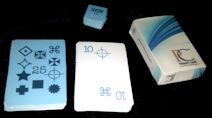
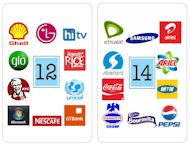
- Quiddler
- This is a rummy-like game in which the combinations are words. It is played with a pack of 118 cards, of which 108 show single letters and 10 show two-letter groups. Players take turns to draw and discard until someone is able to form all their cards into words after discarding. Each of the other players then has one more turn in which they make as many words as they can; then all score the value of the words they have played less the value of the unused cards in their hands.
You can order Quiddler from amazon.com.
- Qwitch
- This game (formerly known as Switch) is played with a 64-card pack and one special die, whose faces show "+", "-" or "=". Each card has a letter and a number - they range from A1 to H8. Players try to get rid of their cards by playing to them to a discard pile. When the die shows "=", each card played must match the previous card's number or letter, so the play is similar to the traditional game of Switch or Eights. If a player runs out of cards or no one can play, the die is rolled and everyone replenishes their hands to five cards. When the die shows "+" the number or letter of each card played must be one more (later) than the previous card, so the play gets stuck if you reach H8. Conversely, when the die shows "-" the number or letter must decrease by one each time and A1 blocks the play. Play can be simultaneous or turn based according to the players' preference.
- Race for the Galaxy
-
This game for 2-4 players designed by Thomas Lehmann and published by Rio Grande Games in 2007 has a mechanism similar to San Juan, but its greater complexity allows for a wider variety of strategies. The main pack of 114 cards contains 64 planets and 50 developments, but can also be used as money (paying to settle a civilian planet or install a develpoment by discarding other cards) or as goods (which can be produced on planets and later traded for cards or consumed for victory point chips). These chips score in addition to the points for planets settled and developments installed. Each player has a set of voting cards which are used to select the phases which will take place in each round, the possibilities being exploration (drawing cards), installation of developments, settlement of planets, trading and consumption of goods, and production of goods. Planets and developments have various powers: some planets can produce, some can consume, some provide military strength that is required to conquer military planets. The key to success is to install a combination of planets and developments that work well together. There are several expansions including a greater variety planets and developments, versions for 1, 5 or 6 players, and extra game features.
You can order Race for the Galaxy from amazon.com. - Rack-O
-
This draw and discard game for 2-4 players was first published by Milton Bradley in 1956 and is now distributed by Winning Moves. It should be fun for children who can count and recognise which numbers are larger than others. Each player is dealt 10 cards from a deck numbered from 1 to 60, and these are held in a fixed order in a rack. Players take turns to draw a card from the deck or discard pile and use it to replace a card in their rack, which is discarded. The aim is to have a rack of 10 cards in ascending order.
You can order Rack-O from amazon.com. - Rage
- A game based on Oh Hell!, played with a 108 card pack consisting of six suits numbered 0-15 plus 12 special cards, which have effects such as changing the trump suit or causing the winner of the trick to gain or lose points.
- Rainbow Poker
- A trick-taking game for 2-5 players based on poker hands, featuring bluff and simultaneous play. The pack has 80 cards: three Aces, Kings, Queens, Jacks and Tens in each of five different coloured suits, plus five wild (multicoloured) cards, one of each rank. Each player is dealt 15 cards which are used to form poker hands for the 5 tricks: a 2-card, 3-card, 4-card, 5-card, and finally a 1-card trick. When comparing hands to decide the winner of a trick, each player can only use cards of one colour to form a combination, the only exception the 5-card 'rainbow', which consists of equal ranked cards, one of each colour. There is a system of bidding and scoring that rewards the player who undertakes to win the most tricks, and allows players to win extra tricks by staking tricks already won.
- Rat a Tat Cat
-
This game from Gamewright is based on the traditional card game Golf. Of the 54 cards, 45 are rats, numbered from 0 to 8 (four each) plus nine nines. Each player has four of these face down, which they try to remember, and the aim is to collect the lowest total and then stop the game. At your turn you draw a card form the stock or discard pile, and can use it to replace one of your cards. There are also nine cat cards with special powers: three allow you to swap one of your cards (unseen) with another player; three give you two extra turns; and three let you peek at one of your cards.
You can order Rat-a-Tat Cat from amazon.com.
- Revenge of the B-Movie
- A quick, undemanding game for 3-6 players - entertaining for those who like creating bizarre movie titles. Each of the 63 cards contains part of a title for a potential B-movie. Using these cards, players build movie titles with as much "cult value" as possible and then attempt to sell their movies by rolling a die.
- Rook®
-
Rook is a deck of 57 cards and also the name of a group of games played with those cards. The cards are sold by Parker Brothers who copyrighted the game in 1906, and under licence by Winning Moves. Some people play Rook with a standard playing-card deck, and there are several other rather similar games played with standard cards in various parts of the world. It is not quite clear which of these are adaptations of Parker's Rook, and whether Rook itself was based on a pre-existing game played with ordinary cards. 93 years after its American debut in 1906 Rook at last landed in continental Europe: in 2009 the French branch of Hasbro began marketing a game called L'Escroc (the Crook) which is Rook in another guise!
You can order Rook or Deluxe Rook from amazon.com. - Roolz
- An expanded version of Rook using a pack of 100 cards. There are six suits numbered from 0 to 15 plus four special cards - two "roolers" and two blank cards. The game is for up to six players; with fewer than five some low cards are removed from the deck. There are two trump suits, one outranking the other, and the roolers are added to these suits as lowest trumps. The blank cards can be used as an alternative to following suit (rather like the fool in classic tarot games). The suits are distinguished only by colour, so the cards may be difficult for colour-blind players to use. the game can be obtained from the inventor Brandon Morris (bmorris@microsoft.com) and a computer version can be dowloaded from the web site.
- Rummikub®
-
A set of 106 coloured and numbered tiles, consisting of two each of numbers 1 to 13 in red, orange, blue and black, plus two jokers, used to play rummy games. Rummikub is credited to Ephraim Hertzano, a Romanian-born Israeli who designed the game in 1955. It was later licenced to the German publisher Intelli and to the American publisher J. Pressman & Co. in 1980. It is striking that the equipment is more or less identical to that used for the traditional Turkish game Okey and for the traditional tile rummy games played in Romania and other south-east European countries.
You can order Rummikub® games from amazon.com. - Rummoli
- This is a Canadian version of Three in One or Poch, played with a standard 52 card pack, some chips for stakes, and a board on which to arrange the stakes. In this version each round consists of two games played with the same cards: first you select five cards with which to play Poker; then you play Michigan (Boodle), and collect chips whenever you play a card or combination corresponding to one of the sections of the board.
- San Juan
- This card version of the board game Puerto Rico was designed by Andreas Seyfarth and published by Rio Grande Games in 2004. The 110 cards can represent buildings, goods or money, depending on how they are placed or used. Players take turns to choose a role - to draw cards, place a card as a building, produce goods, sell goods, etc. Normally the choice allows everyone to perform the selected action, but the player who chose the role gets a privilege. The objective is to score as many victory points as possible by placing buildings, but these must be paid for by discarding cards from one's hand. Some are production buildings which allow goods to be produced and sold for cards, which in turn can be used to pay for more buildings, while others provide enhanced powers or discounts or extra victory points. The original play mechanism involving roles and multi-purpose cards has proved particularly successful and has been used in other games such as Glory to Rome and Race for the Galaxy.
- Sconudi
- This 50-card pack contains 2 copies of each of 25 cards showing the numbers 1 to 5 and the shapes square, circle, triangle, crescent, star. Each card also has a colour (red, yellow, blue, black) and a direction (up, right, down, left, all) but these are determined by the shape and number - for example both the 2 circle cards have colour "blue" and direction "right". The 5 stars cards are "black all directions", and count as wild for colour and direction in most games; the others are evenly spread: 8 different cards of each colour and 6 of each direction. Rules for nine suggested games were provided on the maker's web site (archive copy).
- Senet Card Game
- Taking as its starting point a reconstruction of the ancient Egyptian board game Senet, this game uses cards instead of stick dice to control movement. A hand of five cards gives the player a choice of moves at each turn, using a mechanism similar to that of the North American games Tock and Pegs and Jokers. The card deck consists of 32 cards representing the possible throws of four stick dice, plus seven special hieroglyph cards that allow a pawn to be moved to the corresponding special square on the board. Here is the rule sheet (MS Word document).
- Sequence
- A commercial version from Jax games of a traditional American game, known by various names including One-Eyed Jack. It is played with two standard 52 card decks and a board containing two images of every card except the jacks. When you play a card from your hand you place a chip on one of the corresponding cards on the board, the aim being to achieve a row of five of your chips, known as a sequence. Jacks enable you to place a counter anywhere on the board or remove an opponent's counter.
-
You can order Sequence from amazon.com
- SET®
- Set is an original game using a deck of 81 cards. Players try to be the first to spot matching sets of cards within a layout. This game originated in the USA and has now also been released in Germany.
- Ship Card Game
- The cards for this game are part of the SpaceNTime game system, and will eventually be used in other games with additional components. The 54-card Ship deck, available separately, consists of 12 Clones, 8 Boats, 12 Shuttles, 12 Starships and 10 Wild cards. In the Ship card game players attack opponents using a War-like mechanism to win cards from them, and the object is to collect sets of similar cards that can be traded in for points. A solitaire option is also provided.
- Die Sieben Siegel
-
"The Seven Seals" by Stefan Dorra is published by Amigo and other companies who have sold it under a surprising number of alternative names including Wizard Extreme, Zing and Sluff Off. It is one of the most successful of the many commercial games based on Oh Hell!. The pack consists of 75 cards numbered 1 to 15 in each of five suits, distinguished by colours and symbols, of which 15 are dealt to each player (with fewer than 5 players, the pack is reduced by removing cards equally from the suits). Players must predict not only how many tricks they will win but in which suits. This is done before the play by taking the appropriate "seals" (small coloured discs) from a central pool, to which they are returned as the promised tricks are won. Any seals you have left over at the end of the play count 2 penalty points against you, but if you win a trick for which you do not have a corresponding seal, you must take a black seal, worth 3 penalty points. The red suit is permanently trumps: a player who wins by trumping can choose to to count this as a red trick or a trick in the colour of the suit that was led. In each hand one player, instead of taking seals, can take the role of Saboteur, whose aim is to make sure that as many opponents as possible win unwanted tricks. The fact that all players can see the seals that the other players have chosen to take gives Die Sieben Siegel some extra tactical depth not found in other games of this family.
You can order Sluff Off from amazon.com - Six Generations
- The pack consists of 72 cards representing people of six generations. There are couples from 20 countries of early 19th century Europe and five generations of American descendants (16, 8, 4, 2 and 2 cards) which can be laid out in various ways to form a family tree, the last generation of which is a brother and sister living at the start of the 21st century. Players are dealt 6 cards each and take turns to add a person to the family tree, starting from the European generation and adding descendants, and drawing cards when unable to play. The web site has rules for several other games that can be played with the same cards.
- Sixteen
- A straightforward two-player game from Alpine Games, using a 54-card pack with 13 cards in each of four colours plus two wild cards. In each colour there is a zero and two each of cards 1-6. Playing alternately, players aim to win the play pile by completing a set of three consecutive cards of the same number or colour or by hitting a total of exactly sixteen. Going above sixteen gives the pile to the opponent.
- Skip-Bo
- Skip-Bo was first designed and published by The Skip-Bo Company in 1967. In 1980 the licence was bought by International Games, the creator of Uno. Skip-Bo is a commercial version of Spite and Malice played with a special deck of 162 cards - 12 sets numbered 1 to 12 and 18 "skip-bo" cards which serve as jokers.
You can order Skip-Bo from amazon.com - Skuncum (previously known as Campaign Politiks) [archive copy]
- Although this election game includes a large board for laying out the cards and scoring, it is essentially a card game with an unusual trick-taking mechanism. Each trick represents an election race consisting of a "primary" during which players organise themselves into factions and a "campaign" that determines the winning faction, members of which may score for cards won in the trick. The pack contains 134 cards - 115 "suit" cards representing votes and 19 "action" cards which can be used to affect the outcome.
- Slamwich
- A children's game from Gamewright. This is a game of fast reactions, similar to Egyptian Ratscrew but played with special cards. There are 55 cards, shaped like slices of bread; 40 are various types of food (four of each), 12 are munchers (numbered 1, 2 or 3; four of each) and three are thieves. At your turn you play your next card on the discard pile. If two identical food cards appear in succession or separated by just one other card (a sandwich) or whenever a thief appears, the pile can be claimed by the first player to slap it. Munchers work like the pictures in Egyptian Ratscrew or Beggar my Neighbour - the next player has to play the indicated number of cards, and if this happens without event the muncher gets the pile.
You can order Slamwich from amazon.com - Snag-it
- This game uses a standard pack of cards with jokers, counters and a special game board. When cards are played on the board, adjacent cards must be equal in number or adjacent in number and the same suit. Points are scored for creating spaces where no card can be played, and by playing particular cards to certain special spaces.
- Snakes and Hawks
- A game for 2 to 6 players by Edward Suber using a 60-card pack with four suits each numbered 1 to 15. The basis of the game is similar to Hearts but the dealer has the advantage of choosing the penalty suit and choosing a partner, and also has some control over the passing of cards. In addition to the cards of the suit chosen by the dealer, all the 3's are penalty cards known as snakes and all the 8's are bonus cards known as hawks. However a team that 'shoots the moon' by capturing all four snakes scores a large bonus.
- Soaps
- A card game for 2-5 players in which each player produces a soap opera, using cards representing stereotypical characters (58), events (116) in which the characters can be involved, and marriages between characters (6). Points are scored for the events, according to who is involved. Each turn represents a day and the shows run for four weeks, the last of which is "sweeps week", after which the highest scoring player wins.
- Solitaire for Two
- Formerly known as Indochine 2000, this game is played with a set of tiles corresponding to a six-suited deck of playing-cards. The extra suits are wheels and anchors (green) and there are three jokers, one of each colour, making an 81-card deck. The set is intended for playing an ingenious Solitaire game invented by J.Q.Kansil, but the 81 tiles can clearly also be used for six-suited adaptations of all kinds of card games.
- Somerset
- Somerset is a game of tricks, trumps and bidding with unequal length suits. The designations of the cards look like fractions: 5/8 is the 5 of the 8s suit, and so on, and there is one special card S/S, which is always the lowest trump. The highest bidder chooses the trump suit and points are scored for tricks and for certain scoring cards - the middle card of each suit and the S/S. The Somerset web site, maintained by James Wiersma and Jerry Childs, describes single, double and triple forms of the game played with packs of 28, 50 and 92 cards respectively. Rules and cards for Double Somerset can also be obtained from the SomersetCardGame web site.
- Space Beans
- A game by Uwe Rosenberg. The pack contains 105 cards: 7 suits of 15 numbered cards, each suit with one each of 1-3 and 2 each of 4-9. Players form collections of cards of one suit, and the value of such a collection is equal to the number of cards in it, but only if it contains a card of that number. The mechanism is unusual and works surprisingly well: you have cards in your hand, you can optionally draw from the stock, you play as many cards as you like of one suit to one of your collections on the table, and then pass your whole remaining hand to your left hand opponent (who at this point has no cards). You can only have two collections on the table at a time - the older one face up and the newer one face down; if you want (or are forced) to start a collection in a third suit, you have to cash in your face up collection for what it is worth, if anything, and discard it. The theme of the card designs is an odd mixture of beans and science fiction.
- Spectromancer
- This is a computer game based on trading card games, successor to the older games Astral Tournament and Astral Masters. Players battle for control of the magical plane using creatures and spells.
- Speed
-
Speed was invented by Reinhard Staupe and published in 1995. In North America it is known as Blink and in Israel it is Sprint. It is not quite the same as the traditional game of Speed or Spit played with the 52-card pack, though both games are a race to get rid of cards by playing to two face up discard piles. In the proprietary game of Speed or Blink each card you play must match the previous card on the pile where it is played, either in the shape, colour or number of symbols on the card. There are 6 symbols, 6 colours and 5 numbers, but only 60 cards in the pack, 12 of each number 1 to 5, including two of each number/colour and number/symbol combination.
You can order Blink from amazon.com
- Splink
- This game combines features of several competitive patience games such as Spit, Racing Demon and Spite and Malice. Each player has a pack of 42 cards: 1-10 in each of four colours (cards of two colours have suns, the other two have moons), plus a wild Splink! card and a Freeze card. Play is simultaneous. Cards are built in upward sequence in colour on the central "point piles", and can be stored for later use in private stash piles, which card built in downward sequence alternating suns and moons. The Splink! card can substitute for any needed card, and the Freeze card stops the other player(s) for 5 seconds while you continue playing.
- Stack 21
- As the name suggests, the aim is to form stacks of cards adding to 21. Each player has four stacks, each begun with a face down card. At your turn you draw a card and must play it face up on a stack. A stack of exactly 21 is complete and will score at the end of the game; a stack which goes over 21 is bust and cannot be played on or score. You cannot bust an opponent's stack; if you try to play a card on an opponent's stack that makes it more than 21 the opponent rejects the card and you must play it on your own layout. The deck consists 104 cards: there are numeral cards from 0 to 10, plus four "instant 21" cards which immediately complete a stack by making its total 21. Some of the numerals are "bonus" cards which increase the score if included in a completed stack; some are "keepers" which must be played on your own layout if you draw them. Simple and elegant; well designed cards; easy to learn.
- Sticheln
- A trick-taking game by Klausch Palesch, published in 1993 and renamed Stick 'Em in some English language editions. The first edition, for 3-6 players, was a 90-card pack numbered 0-14 in each of six suits; later editions include 30 extra cards (15-18 in three suits and 15-20 in three suits) to allow up to 8 to play. Each player is dealt 15 cards and puts one face down to represent his or her penalty suit. In the play, all cards greater than zero in all suits other than the suit led function as trumps. Players lose the face value of all cards taken in their own penalty suit but score +1 for each other card taken.
- Stone Soup
- An enhanced version from Gamewright of the traditional game Cheat (sometimes known as "Bullshit"). The cards represent seven types of soup ingredients, and there are extra cards representing stones and salt. As in Cheat, players try to get rid of their cards by playing them face-down to a discard pile (soup), adding ingredients in a fixed order. A player who is caught adding the wrong ingredient has to pick up cards from the pile. The stone cards can never be played legitimately - the only way to get rid of them is to claim they are a valid ingredient and hope not to be challenged. The salt cards can be used to enable a player to pass their turn, thus passing the responsibility of adding the next ingredient to the next player in turn.
- Sushi Go!
- A drafting card game from Gamewright. The 108 cards depict various sushi items - maki rolls, nigiri, sashimi, wasabi and so on. Each player simultaneously displays one item from their hand and passes the remainder on to the next player. This is repeated until the last cards are passed on and displayed, and everyone scores for the sushi combinations they have collected. There is also an expanded version Sushi Go Party! with more cards and scoring possibilities.
You can order Sushi Go! or Sushi Go Party! from amazon.com. - Suds - now renamed Fling
- Summon the Dragon
- This is a game with trumps, tricks and bidding for four players in fixed partnerships. It is slightly reminiscent of Bid Whist, though this may be a coincidence as the author says he has never played that game. The deck has four 13 card suits representing the four elements, plus a dragon card which is the permanent highest trump, or highest or lowest card of any suit at the holder's choice in a "no trump" bid. The high bidder has the choice of exchanging the four card kitty or "summoning the dragon", in which case the holder of the dragon card must give it to the bidder, who discards one card; the original holder of the summoned dragon gets the kitty as compensation and discards three cards. In the play, trumping is compulsory if you do not have the led suit, and the last trick counts as two tricks.
- Swap
- This game is similar to Eights or Uno, but more lively and with even less scope for thought or tactics. It is only necessary to match the colour of the previous play - the cards have no ranks. Some cards have special effects: there are cards that allow players to change the colour that must be played, cards that require players to swap hands, and cards that require the other players to slap the discard pile, the slowest player having to take a card from the person who played the slap card.
- Tack
- A 60-card pack from Gameyex with an unequal distribution of denominations 0-9 (5s, 6s and 7s predominate) in two "suits" (black and white). Each card has various other attributes including a "lens" usually divided into three coloured sectors and somtimes an "archaic icon" in the centre. These can be used for a range of games, some original and some based on traditional games.
- Target
- A draw and discard game in which players collect and score for various types of card sets (straight, flush, three of a kind, etc). There are two decks: the larger deck consists of 82 playing cards: there are numerals 0 to 9 in four suits (cards 2 to 8 duplicated) plus ten wild cards numbered 0 to 9 which can count for any suit; the smaller deck has 28 "target" cards, each of which defines a type of combination which the players can try to make, and the score available for the first who succeeds. Five target cards are turned up and five cards dealt to each player. Whenever a player achieves a combination corresponding to any of these cards, they win the target card and a new one is turned up in its place.
- Tichu
-
This game published by the Swiss firm Fata Morgana Spiele is quite closely related to the Chinese game Zheng Fen. The special pack contains 56 cards, and is rather like a standard 52-card pack with four jokers. The normal suits are replaced by suits of jade, sword, pagoda and star, and the four jokers, each of which has a special property, are the sparrow, the phoenix, the dragon and the dog. Tichu has become quite popular among games enthusiasts in Switzerland and Germany. The Fata Morgana site has a FAQ page with further information and an English translation of the rules of Tichu.
You can order Tichu from amazon.com. - Top Trumps
- This group of games, first produced by Dubreq in the UK in the late 1960's, uses a mechanism similar to that of War, but with special cards each of which has various attributes such as speed, weight, length and so on. Decks have been published based on many different themes. Top Trumps cards can be ordered from the Winning Moves site.
- TraveLight
- A draw and discard travel game in the tradition of Touring and Mille Bornes but with a self-help theme. The aim is to score 1000 by playing "light years" cards - there are 24 of these in the 74-card deck with values of 50, 100 and 200. Your progress can be delayed by "baggage" and "wrong turn" cards and assisted by "reality check" and "movin' on" cards.
- Triple Topper
- This is a pack of 125 cards containing 5 suits, 5 numbers and 5 colours in all combinations. This 'three dimensional' pack can be used to play a variety of games. They include: Craziness (a version of Crazy Eights), Memo-Match (a version of Memory / Pelmanism), Bust the Dafuhzit (a version of Spite and Malice), Caffeine (a version of Speed) and Six Suit (an original game in which you try to give the opponents six cards with a common suit, number or colour). Some of the games are available in Java versions to play online against computer opponents.
- TRIPOLEY®
-
A commercial version of Three in One, containing a deck of cards, chips for the stakes, a cloth layout on which to place the stakes, and rules. In each round three games are played with the same cards: first chips are won for holding cards on the layout, then you select five cards with which to play Poker, and you end the round with a game of Michigan (Boodle).
TRIPOLEY® sets by Cadaco can be ordered from amazon.com. - Tri-Virsity
- A rummy game in which the melds are words. The pack has 132 cards - three suits of different colours each contain 41 letter cards and two wild cards and there are three wild cards that can be used with any suit. Players can meld words of three or more letters of one colour, or extend words that other players have melded. Players score for cards melded according to the point values printed on the cards, and are penalised for unmelded cards when another player goes out.
- Twilight
- A point trick game for 4 players (2 against 2) with an original trick taking mechanism. The pack has 28 cards - 14 sun and 14 moon, and one suit belongs to each team. When it is your turn to play to the trick, a card of your suit must be played. You may either play such a card yourself or direct one of the other three players to do so on your behalf. The trick is won by the player in whose turn the highest card was played, irrespective of suit. The sun and moon cards are distinguishable from the backs so that you can see how many of each suit each player holds. There are a couple of other unusual features. When the highest card (sun or moon) wins a trick, the cards in the trick count for the winner of the following trick. The lowest three cards of each suit are multipliers; they only work for their own team, and they multiply their card points by 1, 2 or 3; if you don't win any of your own side's multipliers in your tricks you score nothing. Twilight was designed by Wolfgang Werner with graphics by Robert Korschofski and is published by Bambus Spielverlag Berlin, whose web site includes the rules in English. There is an English language edition with the name Dr Jeckell and Mr Hyde.
- TZAP Rummy
- A manipulation rummy game, which was launched in Florida in February 2005 and is steadily gaining popularity. Six TZAP cards are added to a standard pack to make a 58-card deck. The TZAP cards can be used either as wild cards or to zap other players, causing them to miss a turn and draw a card from your hand. Some manipulation rummy games have the problem that there is no incentive to meld early, so players just collect cards with the aim of playing them all at once at the end. TZAP rummy neatly discourages this destructive tactic by limiting the number of cards that can be played in one turn, making it risky to hold too many cards in your hand. Other features, including restrictions on the use of wild cards and "locking" of runs that include one wild card make for a well balanced game, and the possibility of zapping opponents can lead to an exciting endgame.
- Uno
-
A popular game of the eights group, first designed and published by International Games, Inc. in 1972. The pack consists of 108 cards including four suits of different cards plus wild cards and special cards for skipping the next player, reversing the direction of play and making the next player draw cards. The UNO site at wonkavator.com has rules and other resources, including news, a forum, and a collection of Uno variants, both official and submitted by players. This site (pagat.com) has a collection of invented variations of Uno submitted by readers.
You can order UNO itself and several other UNO editions from amazon.com. - Vampire, the Eternal Struggle (formerly known as Jyhad)
- A trading card game from White Wolf.
- Verräter
- Verräter (Traitor) is a good but fairly complex strategy game by Marcel-André Casasola, which feels much more like a board game than a card game. The 'board' consists of 12 cards representing territories, to be arranged in a circle. They can be turned over to show their allegiance to either of two factions. Each of the three or four players can also support one or the other faction, and it can often be profitable to change sides during the game - hence the name Verräter (traitor). There are other cards representing player roles and actions and resources that can be used in conflicts.
- Vici
- In this unusual game, the four players take turns to pass cards to other players and receive replacements, the aims being (a) to collect a hand of only one suit and (b) to identify correctly who is collecting each of the other suits. The card designs have an ancient Roman theme; the 56 card pack has the usual suits of hearts, clubs, spades and diamonds, but each suit contains both a 'one' and an 'ace', for a total of 14 cards per suit.
- Vie
- A word game using a deck of 54 square cards showing from one to four letters. These are played in a 3x3 square grid: on your turn you cover one of the grid cards with a new card and score for words in the row and column of the card you played that use the letter(s) on it. Many of the cards can be played in two or four different orientations to give different sets of letters.
- Wackee Six
- A variation of the traditional game of Racing Demon or Nerts, with packs with different coloured backs for up to six players. The cards have large numbers from 1 to 13 in four colours in place of the traditional suits. Each pack also includes two wild cards, which can be played in place of any needed centre card provided that the next card in sequence is played at the same time. The players race to get rid of a row of six face up cards and a face down stack of six cards which replace the face up cards as they are played to the centre.
- WaterworksTM - also known in a German edition Leg das Rohr
- The pack consists of cards that show lengths of pipe - straight, curved and with junctions, with and without leaks, plus valves, spouts and spanners to repair the leaks. By playing cards to a layout you try to be first to complete a water-tight pipe of the required length from your valve, ending in a spout. Waterworks is now produced by Winning Moves.
- WhizORD
- A straightforward word game played with a pack of 108 cards showing letters of the alphabet. Each player is dealt seven cards, can discard some of them and draw replacements, and must then make the highest scoring word they can.
- Whot!
- This is one of the earliest commercial games based on the traditional game of Eights. First published by Storey & Co in Britain in 1935 and later by Waddingtons, it uses an unusual 53-card pack consisting of five unequal suits (circles, squares, triangles, crosses, stars) and four or more wild Whot! cards which are used to change suit. Although it is no longer so well-known in Britain, it has become extremely popular in Nigeria.
- Wingo Dingo
- Two identical packs of 27 cards, each card showing eyes, mouth and head in a different colours, plus three special cards. Two games are offered: in one you guess the identity of a card hidden by your opponent, using information on how closely it matches various cards that you play; the other is a version of Snap.
- Wizard
-
This is a variation of the traditional game Oh Hell! - it is officially for 3-6 players but can be adapted for any number from 2 to 12. Eight special cards - four jesters and four wizards - are added to the standard pack, making a total of 60 cards. In the first deal each player is dealt 1 card; the size of hands increases by one in each deal, until the whole pack (or as much of it as possible) is dealt. A card is turned up to determine the trump suit; if it is a wizard, the dealer chooses the trump suit; if a jester, the hand is played at no trump (making the wizards particularly valuable, as they retain their power). Players can bid any number of tricks - the bids may or may not add up to the total tricks available. You score only if you make your bid exactly; if you take too many or too few tricks you lose. The wizards and jesters can be played to any trick. Wizards always win the trick (if several are played to the same trick the first wins) and jesters lose (a trick consisting entirely of jesters is won by the first played). If a wizard is led to a trick the other players may play any cards. If a jester is led, the next player may play any card, and this determines the suit to be followed. An online version of Wizard with owls for wizards and moles for jesters is available as Oh Hell! at Game Duell
. Wizard can also be played by e-Mail on Richard's Play-By-eMail Server.
You can order Wizard from amazon.com - Yu-Gi-Oh!
- A trading card game based on comics and TV animations by Kazuki Takahashi.
- Zêtre
- A four-suited deck, with five "letters" in each suit instead of three ("JQK"). Three dice are rolled, and players attempt to form totals equal to the cards in their hand by applying numerical operations to the numbers showing on the dice.
- Zoff im Zoo - see Frank's Zoo
- Zoki
- A set of 34 square cards, marked on their four sides with 0, 1, 2 or 3 stripes. They can be used for a variety of games. Some involve building a layout where that touching sides of adjacent cards match; others are inspired by various traditional card games.
- Zoolu
- This is a draw and discard game played with a 66-card pack. 50 of these show animals of five colours (Green, Blue, Orange, White and Pink) and five types (Cheeky, Freaky, Zany, Cutesy and Cruisy). Then there are 3 Chameleons which can be used as any colour or type and 13 Kaos cards which have various special effects when discarded. The aim is to collect five animals of the same colour or the same type: the colour or type you must collect is determined by a 'target card', which is dealt to you from a separate pack of 20 cards containing two of each possible target.
